
Sedum with mild-flavord leaves. Photo by Green Deane
Confessions of forager: In a general sense I have known for many years that “Stonecrops” were edible. I avoided them as they were usually associated by writers with cactus (In that they grow well where it is warm and dry znd rocky. Where I live it is hot, wet and no rocks.) So I ignored “stonecrops” for decades except for two: one a distant edible relative I stumble across in Florida, Ice Plant, Carpobrotus edulis, and sedum purpureum which I played with as a kid in Maine but didn’t eat. We called it frog belly.
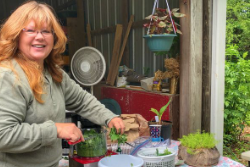
Suzanne Shires making pesto. Photo by Donna Horn Putney
So when I saw this past weekend herbalist Suzanne Shires and our event host Donna Putney eat two different species of Stonecrop they caught my attention. We were at an event at Putney Farm in South Carolina where I taught four classes and had the opportunity to hear Suzanne talk about plants. (If you can possibly do so attend any presentation of hers, and Donna’s.) The result: I have clippings from Donna of stonecrop. I will probably have to wait until they bossom to identify them down to the species, but I know they are edible! We had some in a pesto. There are several species of stonecrop with a history of edibility. Among them Sedum, sarmentosum (high in vitamin C) S. roseum, S. rhodanthum, S. reflexum, S. telephium var. purpureum, and S. acre and several more. Roots of Sedum roseum are eaten after being cooked. The roots of S. roseum are also a common supplement sold under the name Rhodiola rosea. The roots of S. telephium var. purpureum have also been eaten. Sedum. telephium var telephium is a cultivated salad plant in Europe, the leaves are used. S. acre has pungent leaves and is used as a condiment. Native Americans used S. divergens, and S. laxum for food, the latter rolled with salt grass. The red tops of Sedum integriforlim ssp. integrifolium were used to make a tea, or the leaves eaten fresh or with fat, the root was also eaten. S. rosea (The rhodiola) was eaten fresh, cooked or fermented. Roots eaten with fat or fermented. (I will ferment Ice plant the next time I run across it.) There are between 400 and 475 different species of Sedum. Interestingly kalanchoe is in the wider stonecrop group though I have never heard of any of them being edible.Avoid Sedum alfredii which is known to accumulate cadmium. Contemporary references say Sedum means “House Leek” in Dead Latin. Merritt Fernald,the Big Botanical Man at Harvard from 1900 to 1950, author of Gray’s Manual of Botany 1950 (the year he died) says “Name [is] from sedire, to sit, alluding to the manner in which many species affix themselves to rocks or walls.”
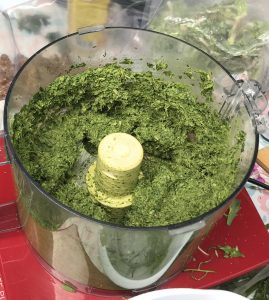
Forage Pesto. We picked all the seeds off the cleavers (which I am going to roast.)
Forage Pesto? Yep. Suzanne Shires, above left made a foraged pesto for Sunday’s class. Among the plants used were cleavers– minus seeds — chickweed, Stinging nettle, dandelions, Jeruselam artichoke leaves, rumex leaves, strawberry leaf, spider wort and sedum (The goal by collecting different species was to create a familiar taste and texture.) Olive oil, sunflower seeds and black walnuts and nutrutioinal yeast (which added a cheese flavor) rounded out the ingredientw, salt to taste. Besides being an herbalist Suzanne also has the cooking knowledge of what to forage to make into various meals. Her new book is Beyond the Garden Gate, Wild food Recipes. Her previous book is Wild Herb Gardening. Available here.
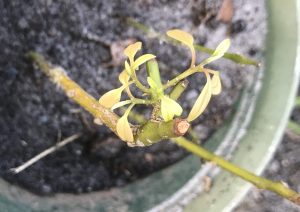
Cinnamon Sprig
The do-it-yourself plant world can hold many surprises. Years ago while trying to collect vinegar bacteria from scratch I failed completely for about five years. Then while doing something else I accidentally succeeded finding a sure fire way to collect the bacteria. A couple of months ago I potted a couple of dozen cinnamon seeds. No sprouts. I put some leafless twigs — collected at the same time — in water in and left them outside with daily sun ignoring them (not wanting to throw them.away.) Now I have a leafing sprig. The photo left is the result, it’s been potted and at the end of the year I’ll move it to a new location.
Foraging classes: Two favorite locations this weekend, Dreher Park on Saturday and Mead Gardens in Orlando on Sunday. Subtropical to subtemperate plant communties.
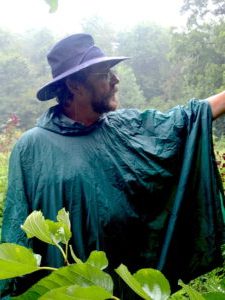
Classes are held rain or shine (but not during hurricanes.)
Saturday May 14th Dreher Park, 1200 Southern Blvd., West Palm Beach, 33405. 9 a. m. to noon. Meet just north of the science center.
Sunday may 15th, Mead Gardens, 1500 S. Denning Dr., Winter Park, FL 32789. 9 a.m. to noon. Meet at the bathrooms.
Saturday May 21st Eagle Park Lake, 1800 Keene Road, Largo, FL 33771. 9 a.m. to noon Meet at the pavilion near the dog park.
Sunday May 22nd, Colby-Alderman Park: 1099 Massachusetts Street, Cassadaga Fla. 32706, 9 a.m. to noon. Meet at the bathrooms
Saturday May 28th Bayshore Live Oak Park, Bayshore Drive. Port Charlotte. 9 a.m. to0 noon. Meet at the parking lot at Bayshore and Ganyard.
Sunday May 29th Mead Gardens, 1500 S. Denning Dr., Winter Park, FL 32789. 9 a.m. to noon Meet at the bathrooms.
For more information, to pre-pay or sign up go here
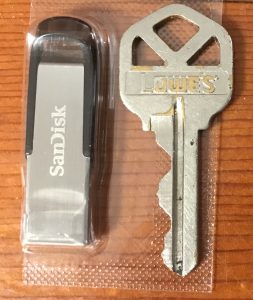
You get the USB, not the key.
My nine-DVD set of 135 videos has been phased out and replaced by 171-videos on a 128-GB USB, see left. The USB videos are the same videos I have on You Tube. Some people like to have their own copy especially if social order falters. The USB videos have to be copied to your computer to play. If you want to order the USB go to the DVD/USB order button on the top right of this page or click here. That will take you to an order form. Or you can make a $99 donation, which tells me it is for the USB (include a snail-mail address.) I’d like to thank all of you who ordered the DVD set over the years which required me to burn over 5,000 DVDs individually. I had to stop making them as few programs now will read the ISO files to copy them. Burning a set also took about three hours.

Green Deane Forum
Want to identify a plant? Perhaps you’re looking for a foraging reference? You might have a UFO, an Unidentified Flowering Object, you want identified. On the Green Deane Forum we — including Green Deane and others from around the world — chat about foraging all year. And it’s not just about warm-weather plants or just North American flora. Many nations share common weeds so there’s a lot to talk about. There’s also more than weeds. The reference section has information for foraging around the world. There are also articles on food preservation, and forgotten skills from making bows to fermenting food. Recent topics include: Fermenting potatoeswith yogurt, make a water filter, nixtamalization at home, Stale Bread and Cod Liver Oil, Life’s a Grind, Killing Bugs with Tobacco Plugs, Eating weeds: Is it safe? Have they mutated? Not the Eastern Red Bug but the Pink Tabebuia, African Tulip Tree, Asparagus densiflorus, Green Deane’s Book… You can join the forum by clicking on the button on the upper right hand side of this page.
Did you know there are two elderberry cultivars, john and Adam: They were bred from Sambucus canadensis and have larger berries and ripen sooner than the wild kind. Now you know. I think this picture is of a “John”
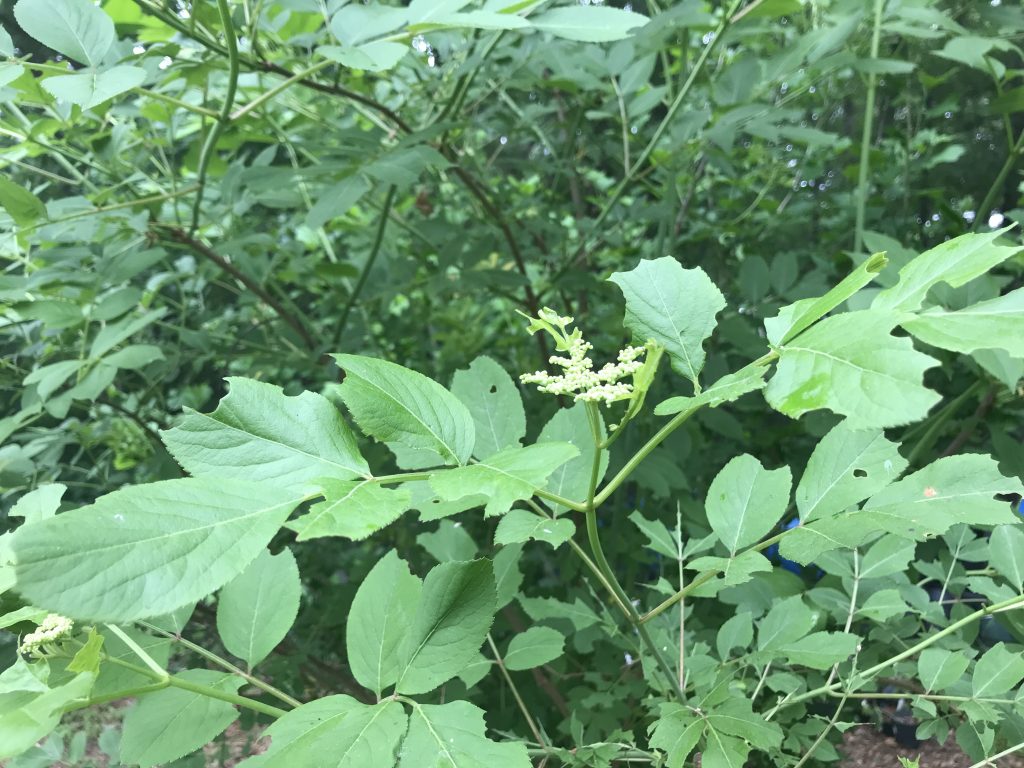
An Elderberry cultivar, “John”. Photo by Green Deane
This is my weekly newsletter #507. If you want to subscribe to this free newsletter you can find the sign-up form in the menu at the top of the page. My website, EatTheWeeds.com, which is data secure, has over 1500 plants on it in some 428 articles. I wrote every one myself, no cut and paste.
On a personal note, my rent is doubling. I need a place to move to. Currently renting a two-bedroom small house. Looking for either a rental or place to buy. Email Green Deane@gmail.com
To donate to the Green Deane Newsletter click here.


Thanks so for your tireless efforts to teach us all you know including foraging. I can’t wait for your Book. I couldn’t find S Shires books anywhere. Hope you are feeling well!
We were absolutely thrilled to have you here! The weekend was magical!
We can’t thank you enough for taking the time to share your wisdom with us!